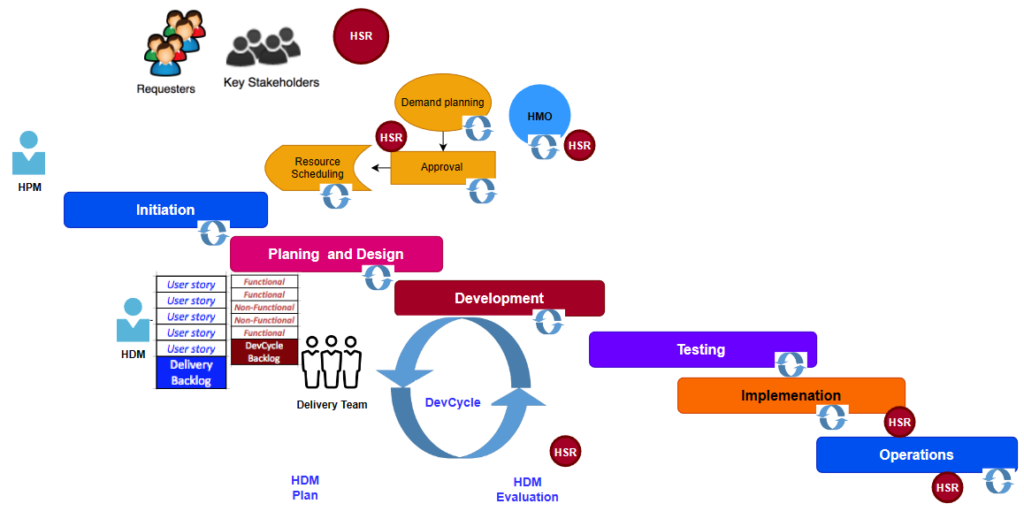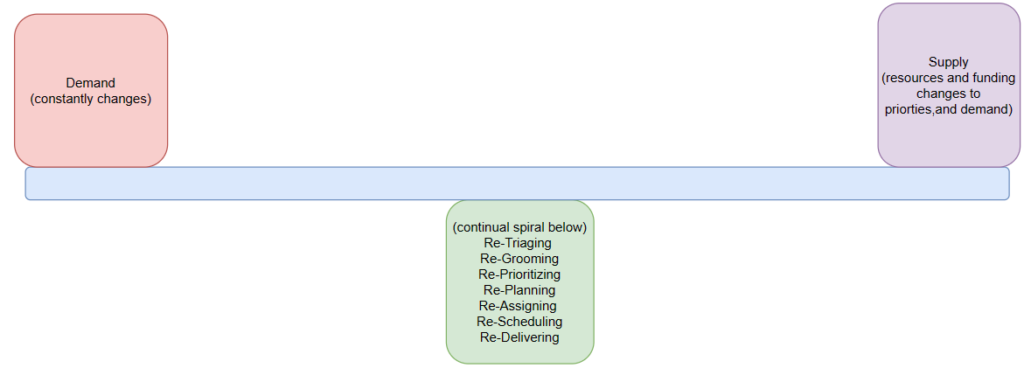Model Outline for BEAHUb.org
Definition:
Why BEAHUb.org is Needed:
Three Main Parts of BEAHUb.org
BEA Hybrid Delivery Implementation Approach

Key Components and Elaborations:
- Demand Planning and Its Separation:
- Rationale for Separation: Given that project demands fluctuate with changing organizational needs, it’s crucial to separate demand planning. By doing so, we maintain a flexible approach to project intake, enabling the organization to pivot as required without disrupting established workflows.
- Demand Creation: Initiators or requesters channel their needs into the Business Enterprise Architecture projects, ensuring that projects align with current requirements.
- Stakeholders and Their Influence: While not always directly involved in project processes, key stakeholders shape the trajectory and priorities, necessitating their inclusion in the wider view.
- Hybrid Management Office (HMO): Replacing the traditional PMO, the HMO oversees the integration of Agile into the Waterfall structure, ensuring that projects remain adaptive without losing their direction.
- Waterfall Methodology – Detailed Stages and Agile Integration:
- Overview: Each stage of the Waterfall process, from initiation to operations, provides a structured backbone for projects.
- Initiation: This stage lays down the blueprint, establishing the project’s scope, direction, and objective.
- Planning & Design: Here, the core strategies and designs are developed. It is within this stage that the Agile phase becomes particularly prominent. The HPM takes the lead, understanding the broader objectives, translating them into Agile deliverables, and liaising with the HDM.
- Development: The outputs from the planning stage are converted into actionable tasks. Simultaneously, the Agile cycle ensures that this development remains iterative, responsive, and aligned with initial goals.
- Testing, Implementation, and Operations: Each of these stages also incorporates Agile cycles, ensuring that the final output remains in tune with user expectations and the changing landscape.
- Pervasive Agile Cycles: Within each Waterfall stage, Agile is not just an add-on but a deeply integrated component. Its iterative ‘dev cycles’ are infused into every phase, allowing for continuous feedback, evaluation, and recalibration.
- Deep-Dive into Agile Phase:
- Creation of the Delivery Backlog: The Agile phase becomes more pronounced between the initiation, planning, and development stages of the Waterfall method. Here, the backlog is not just a list but a dynamic set of user stories and requirements derived from the structured Waterfall stages.
- Hybrid Project Manager (HPM) and Hybrid Delivery Manager (HDM): The HPM acts as a bridge, understanding both Waterfall and Agile, while the HDM operationalizes these into the Agile framework. This synergy ensures that there is no loss in translation, and projects remain aligned with both methodologies.
- Evaluations and Reviews: Outputs are subject to rigorous HDM Evaluations, ensuring that what’s developed aligns with user expectations. Additionally, the Hybrid Strategic Review (HSR) at each stage aligns project outputs with organizational strategy.
- Role Dynamics and the Concept of ‘Hats’: In the BEA Hybrid approach, roles like HPM, HDM, and those in the HMO are not fixed labels. They are ‘hats’ that individuals can wear. A person can wear multiple hats, switching between them based on project requirements or phases. For instance, an individual could be the HPM in one project and take on HDM responsibilities in another. This flexibility in roles facilitates efficiency and streamlines resource allocation.
- Adaptability of the BEA Model: This unique model is versatile, applicable not only in Business Enterprise Architecture but also in domains like project management, change management, and process design.
To encapsulate, the BEA Hybrid Delivery Implementation Approach offers a structured yet flexible project management method. By intertwining Waterfall’s rigid structure with Agile’s adaptability, it addresses the dynamic nature of project demands while ensuring organizational objectives are never sidelined.
The Promise of BEA
At the heart of BEA lies the promise of reducing failure rates in large change projects by establishing a strong foundation and guiding principles akin to nurturing a child’s growth. It emphasizes a balanced approach, avoiding over-control and under-control, and promotes continuous learning and development. This analogy of child-rearing embodies BEA's vision of adaptability, resilience, and long-term growth.
AI in BEA
At the heart of BEA lies the promise of reducing failure rates in large change projects by establishing a strong foundation and guiding principles akin to nurturing a child’s growth. It emphasizes a balanced approach, avoiding over-control and under-control, and promotes continuous learning and development. This analogy of child-rearing embodies BEA's vision of adaptability, resilience, and long-term growth.
BEA in Practice
In practice, BEA involves the application of various project management principles, change management techniques, lean principles, IT Service Management (ITSM), and technical architecture. This multi-disciplinary approach helps establish robust governance and risk management structures, align business strategy with enterprise architecture, and manage complex adaptive systems.
Future of BEA
Looking forward, BEA will continue to evolve, reflecting emerging trends and advancements in technology. It will play a crucial role in navigating the landscape of cloud services, harnessing the power of AI, Blockchain, and other emerging technologies. Join us on this exciting journey as we delve deeper into BEA, explore its many facets, and work together to shape its future. Your insights, experience, and expertise can help make BEA even more valuable for organizations worldwide.
Business Enterprise Architecture Model: Balancing Demand and Supply

Objective: This model addresses the core challenge faced by business enterprise architecture organizations: striking a balance between demand and supply. Given that both elements are in constant flux, it becomes imperative for businesses to realign their strategies accordingly.
Components:
- Demand: It represents the needs and wants of your stakeholders. This could be your customers, management, or even citizens in some cases. The demand side is inherently dynamic, and keeping up with its changes is crucial for business success.
- Supply: This component encompasses what the organization can provide in terms of funding, resources, and prioritization. Understanding your supply side means having a grip on available assets and how they can be best allocated.
The Realignment Process:
As the landscape of demand and supply shifts, businesses must undergo a series of adjustments. Here are the stages involved:
- Triaging: At this stage, businesses identify what’s most essential. It’s about understanding what demands are most pressing and need immediate attention.
- Re-grooming: This is an analytical phase where you reassess and determine what needs to be done based on current conditions.
- Reprioritizing: Given the shifting sands of demand and supply, re-establishing priorities becomes crucial. What was essential a month ago might not hold the same significance today.
- Replanning: With new priorities in place, it’s time to strategize how you’ll address them.
- Reassigning: Determining who in the organization will handle what tasks. It’s about distributing responsibilities effectively.
- Rescheduling: This pertains to time management. When will a particular demand be addressed? When will the results be visible?
- Redelivering: This is the execution phase where strategies are put into action, and deliverables are rolled out.
Relation to Cybernetics:
The model draws parallels with cybernetic principles, which stress the importance of feedback loops and adaptive systems. Just as in cybernetics, this model emphasizes the need to constantly monitor, assess, and adjust based on feedback. It’s a cycle of understanding, adapting, and evolving, much like the trajectory discussions centered around “the holiday of Ricky” (though more context is needed to fully understand this reference).
In conclusion, this model serves as a compass for business enterprise architecture organizations, guiding them through the unpredictable waters of demand and supply. It is a blueprint for staying relevant and effective in a continually changing business environment.